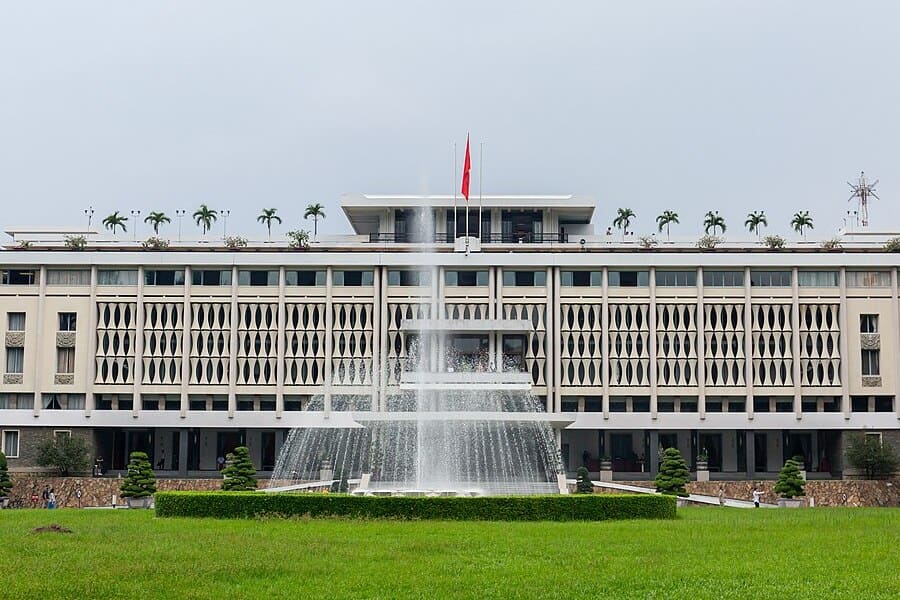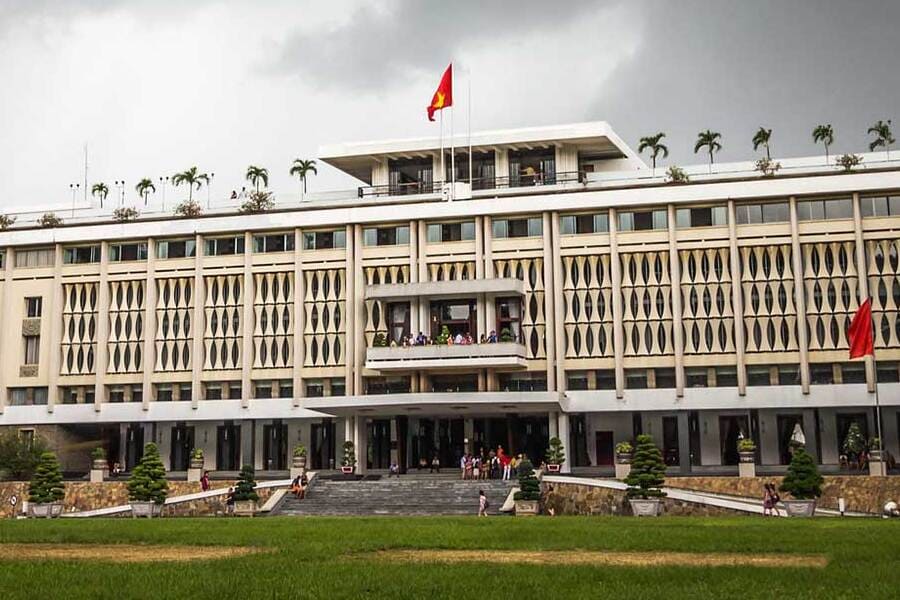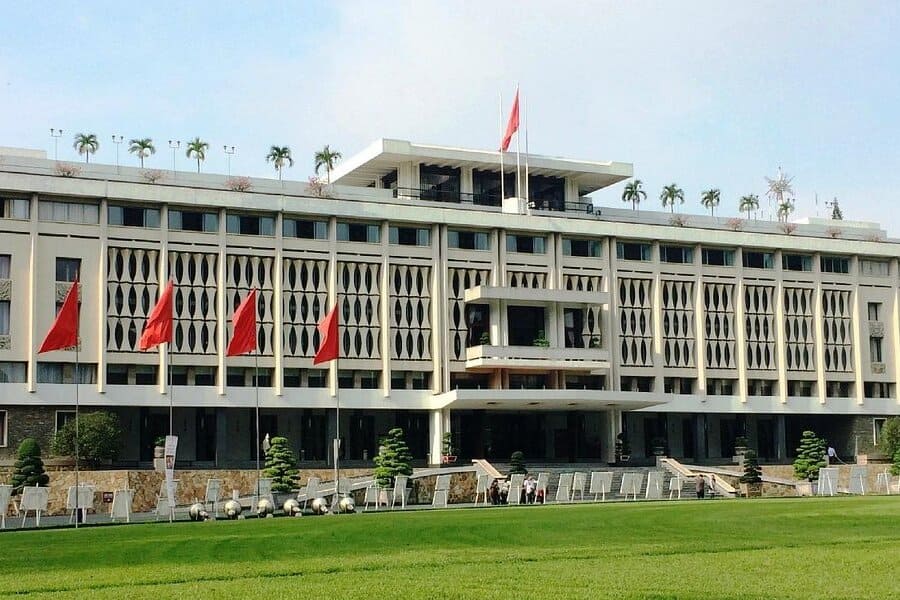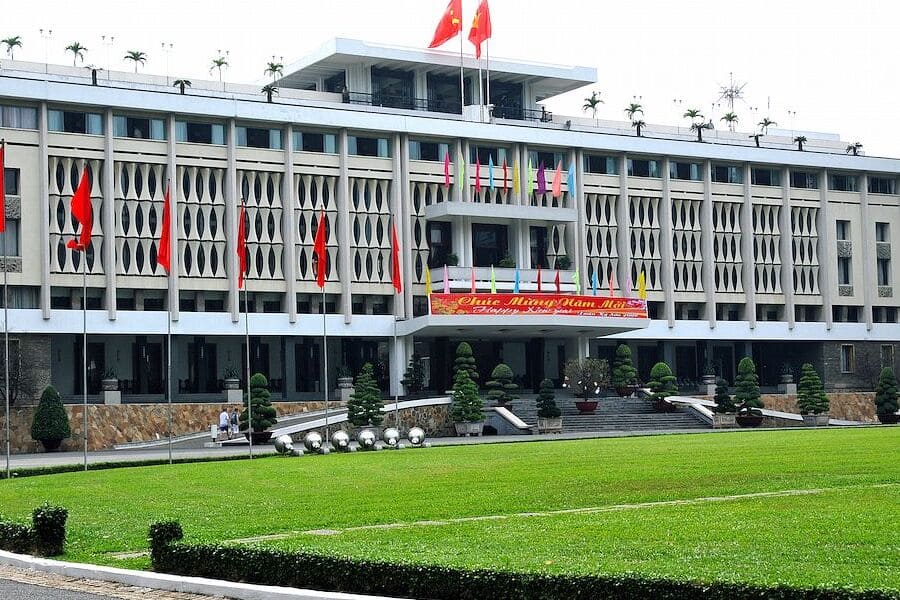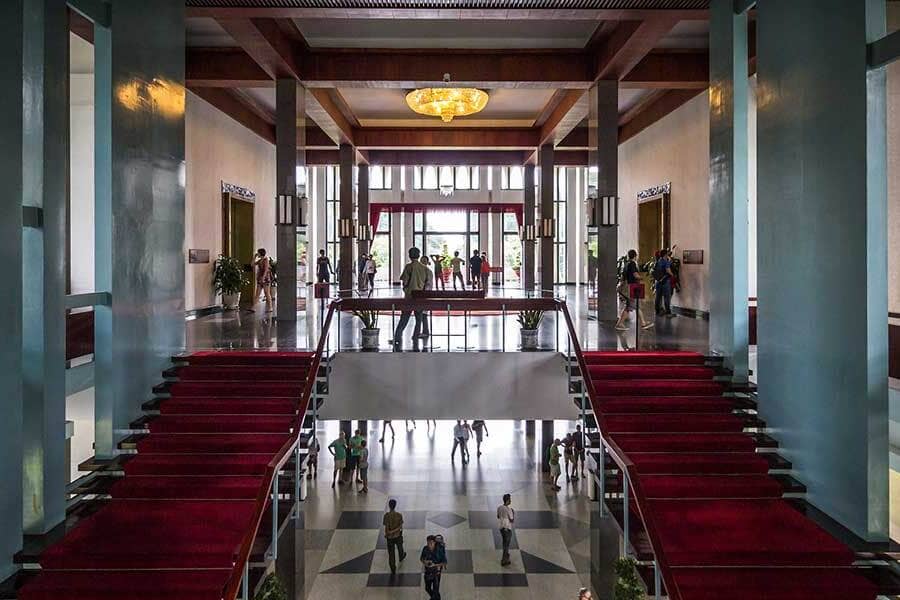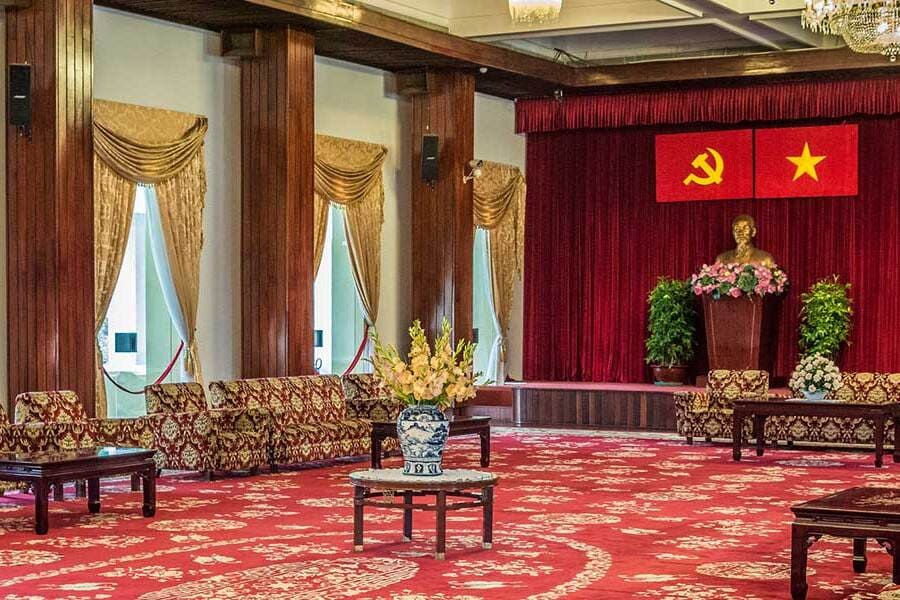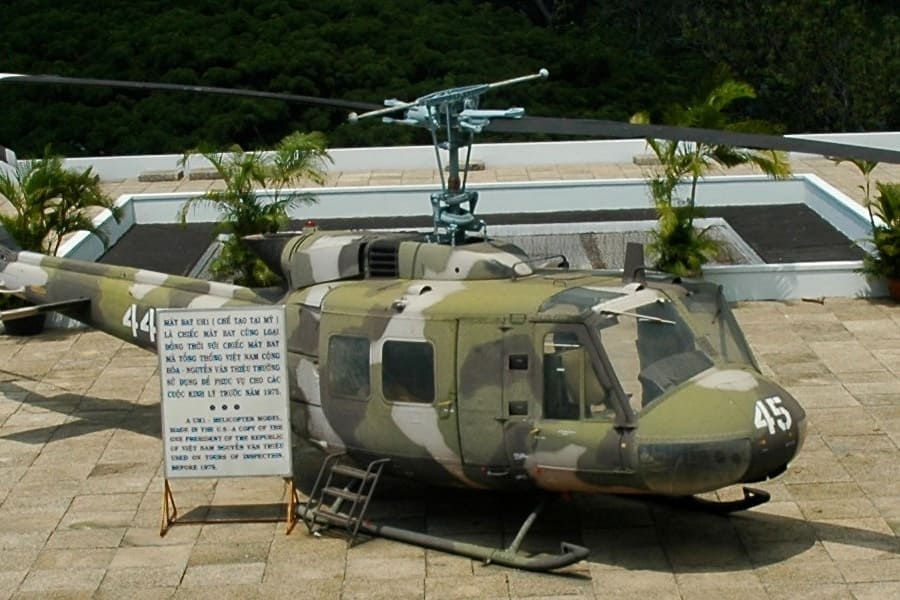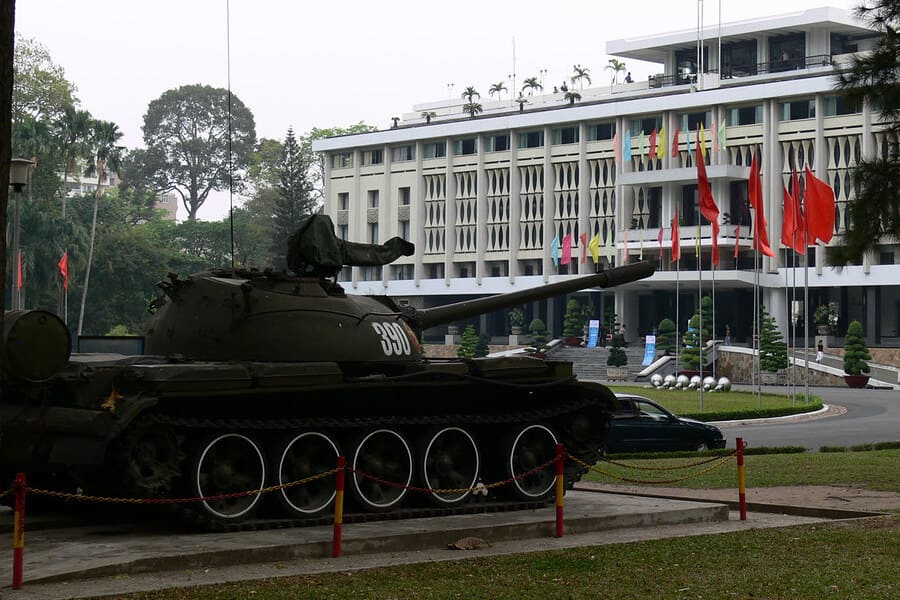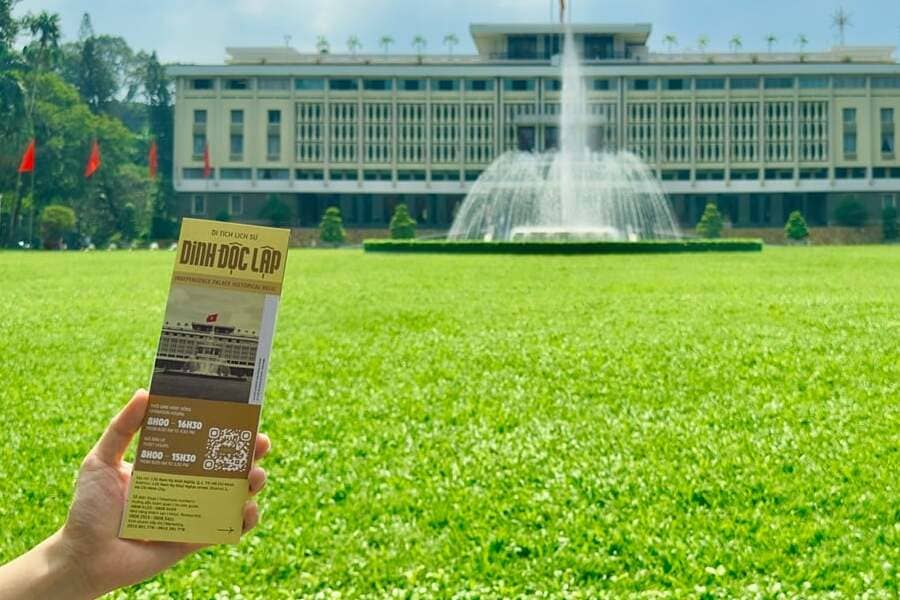The Reunification Palace stands proudly in Ho Chi Minh City as a testament to Vietnam’s rich history and cultural heritage. Vietnam shore excursions often include a visit to this historic landmark, which served as the official residence and workplace of the President of South Vietnam during the Vietnam War. The palace witnessed pivotal moments in Saigon’s history and played a central role in Vietnam’s path to reunification.
Symbolizing victory, peace, and territorial integrity, the palace’s elegant design features hundreds of rooms adorned with luxurious furnishings and decorations. Its expansive grounds offer visitors a tranquil retreat from the bustling city, providing a glimpse into one of Ho Chi Minh City’s most iconic and historically significant structures.
Location of Reunification Palace in Ho Chi Minh City
Located at 135 Nam Kỳ Khởi Nghĩa Street, Ben Nghe Ward, District 1, Ho Chi Minh City, Vietnam, the Reunification Palace spans an impressive area of approximately 120,000 square meters (300 meters x 400 meters). This architectural marvel showcases a unique blend of modern Western and traditional Eastern design styles.
Positioned prominently, the palace is surrounded by four major streets Nam Kỳ Khởi Nghĩa Street to the northeast, Huyen Tran Cong Chua Street to the southwest, Nguyen Thi Minh Khai Street to the northwest, and Nguyen Du Street to the southeast.
Inside, Ho Chi Minh City shore excursions visitors can explore its vast grounds featuring lush green gardens, ceremonial rooms, and underground bunkers. It serves as a significant historical site, offering insights into Vietnam’s history and serving as a symbol of the nation’s struggle for independence and reunification.
The Reunification Palace remains a popular destination for tourists seeking to delve into Vietnam’s past and admire its architectural grandeur.
History of Reunification Palace Vietnam
The Reunification Palace in Ho Chi Minh City, formerly known as Independence Palace, has a rich and tumultuous history that spans pivotal periods of Vietnam’s past. Nowadays, the Reunification Palace stands as a historic landmark and museum in Ho Chi Minh City, offering visitors insights into Vietnam’s turbulent past and its journey towards reunification and independence.
Norodom Palace Era (1868)
Originally constructed by the French colonial authorities in 1868, Norodom Palace was designed as the residence for the Governor of Cochinchina, a region of French Indochina.
Japanese Occupation Period (1945)
During World War II, Japan occupied Vietnam and used the Norodom Palace as its headquarters from 1945 until the end of the war.
French Return and Defeat Period (Post-1945 to 1954)
After World War II, the French regained control of Vietnam briefly until their defeat at the Battle of Dien Bien Phu in 1954. Norodom Palace continued to serve as a symbol of French authority during this period.
Republic of Vietnam Era and Renaming (1954 onwards)
Following the Geneva Accords of 1954, Vietnam was temporarily divided into North and South. Norodom Palace was then used as the office and residence of the President of the Republic of Vietnam, Ngo Dinh Diem. It was renamed Independence Palace, symbolizing South Vietnam’s aspirations for autonomy.
Bombing and Reconstruction Incident (1962-1966)
In February 1962, the palace was severely damaged during a bombing raid by dissident South Vietnamese pilots. This event prompted President Ngo Dinh Diem to commission a new palace, and reconstruction began immediately. Architectural work was overseen by Vietnamese architect Ngo Viet Thu, and the new Independence Palace was completed in 1966.
Fall of Saigon and Unification of Vietnam (1975)
The most iconic moment in the palace’s history came on April 30, 1975, when Communist Vietnam soldiers’ tanks crashed through its gates, marking the end of the Vietnam War and the reunification of North and South Vietnam. This event cemented the palace’s significance as a symbol of national unity and the end of decades of conflict.
Reunification Palace’s Architecture
The exterior of the Reunification Palace
Oval Lawn and Semicircular Lake
The front yard features a large oval lawn surrounded by a semicircular lake. This creates a serene and picturesque setting reminiscent of traditional Vietnamese temple gardens.
Green Parks and Gardens
The palace grounds include expansive green parks and meticulously maintained gardens. These areas are adorned with ancient trees and ornamental plants, providing a peaceful retreat within the bustling city.
Main Building Layout
The main building of the palace is structured with a width of 80 meters. It spans three floors, two mezzanines, a terrace, a ground floor, and a basement. The layout is designed to accommodate various functions and is a blend of modern and classical architectural styles.
Octagonal House and Tennis Courts
Adjacent to the palace, facing Nguyen Thi Minh Khai Street, stands an octagonal house with a distinctive curved tile roof. Surrounding the palace are also well-maintained tennis courts, offering recreational spaces amidst the historical setting.
The Interior of the Reunification Palace
Main Hall and Grand Staircase are the main hall is grand and spacious, often adorned with elegant decor. A prominent feature is the grand staircase, which is a central focal point upon entering the palace.
The Chamber
A room used for meetings, receptions, and official ceremonies, accommodating over 800 people.
Credentials Room
Houses the painting “Binh Ngo Dai Cao,” depicting peaceful Vietnamese life in the 15th century.
Library
Contains books and research papers belonging to former presidents.
Strategic Operations Department Room
Where military data from various tactical regions were collected and operations were coordinated.
Residence of the Presidential Family
The living quarters were used by the presidential family during their stay at the palace.
Basement
Designed by Lieutenant Colonel Phan Van Dien, it includes a network of tunnels and rooms used for various purposes, including telecommunications and wartime operations.
What does Independence Palace have?
The Reunification Palace houses several historical artifacts
President Thieu’s Helicopter
On display is the UH-1 helicopter used by President Nguyen Van Thieu. It holds historical significance as part of the events during his presidency.
German Mercedes
A Mercedes Benz 200 W110 with the registration plate VN-13-78, notable for being used by President Thieu during his tenure.
Revolutionary Forces Jeep
This Jeep M152A2 was used by Revolutionary Forces, including the last President of the Republic of Vietnam, Duong Van Minh. It played a significant role during the historic events leading to the fall of Saigon.
The artworks at Reunification Palace
Oil Paintings
These paintings depict various scenes and figures significant to Vietnamese history and culture. They often showcase landscapes, historical events, or portraits of important figures.
Pottery
The palace houses a collection of ancient Chinese pottery, predominantly from the Ming and Qing dynasties. These artifacts reflect the cultural exchanges and influences between Vietnam and its neighboring countries throughout history.
Reunification Palace Tanks
The tanks displayed at Reunification Palace are replicas that commemorate the historical significance of the Vietnam War. These tanks symbolize the pivotal moment when North Vietnamese Army tanks breached the gates of the palace on April 30, 1975, marking the fall of Saigon and the reunification of Vietnam. These replicas serve as a reminder of the military events that shaped the course of Vietnamese history.
Travel Guide for Visiting the Independence Palace in Vietnam
How to Get to the Independence Palace
On Foot/By Motorcycle/Private Car
The palace is located in District 1 of Ho Chi Minh City, making it accessible by walking, motorcycle, or private car. It’s advisable to ask locals for directions if you’re traveling on foot or by motorcycle.
By Taxi
Taking a taxi is a convenient option to reach the Reunification Palace. Simply tell the driver the name of the palace, and they should know the location. Taxis are readily available throughout Ho Chi Minh City.
By Bus
There are specific bus routes that pass by or near the Reunification Palace. Look for buses that travel through District 1 or specifically mention the palace as a stop. Bus routes can vary, so it’s helpful to check local bus schedules and routes beforehand for the most efficient journey.
Opening Hours of Reunification Palace
Reunification Palace is open daily, including holidays and Tet (Vietnamese Lunar New Year), from 7:30 AM to 11:00 AM and from 1:00 PM to 4:00 PM.
Entrance Fee of Reunification Palace
The entrance fee for visitors is typically 40,000 VND for adults. There are usually discounted rates for students (about 20,000 VND) and children (about 10,000 VND). However, these fees may vary, so it’s advisable to check the official website or inquire locally for the most current information.
Things to Note When Visiting Reunification Palace in Ho Chi Minh City
Adhering to these guidelines ensures a respectful and enjoyable experience while visiting Independence Palace.
Dress Code and Conduct
Visitors are advised to dress modestly and respectfully. It is recommended to avoid wearing shorts, mini-skirts, or clothing that exposes too much skin out of respect for the historical significance of the palace and Vietnamese cultural norms.
Visitor Responsibilities and Rules
- Follow the instructions provided by palace staff and security personnel.
- Refrain from touching or damaging any artifacts, displays, or historical items within the palace.
- Obtain permission before taking photographs, as some areas may have restrictions.
- Eating, drinking, and smoking are generally prohibited inside the palace premises.
- Maintain respectful behavior throughout the visit to uphold the solemnity and historical integrity of the site.
Restaurants Near Reunification Palace in Ho Chi Minh City
Near Reunification Palace in Ho Chi Minh City, you can find several restaurants offering a variety of cuisines. These restaurants provide a range of dining experiences, from traditional Vietnamese flavors to international dishes, all within proximity to Reunification Palace.
- Nha Hang Ngon – Known for its traditional Vietnamese dishes in a bustling setting
- Secret Garden – Offers Vietnamese cuisine in a cozy rooftop garden setting.
- Chả Cá Thăng Long – Famous for its Chả Cá Lã Vọng (grilled fish with turmeric and dill) in a traditional Vietnamese setting.
- Cuc Gach Quan – Features Vietnamese comfort food in a charming, rustic atmosphere.
- The Garlik De Tham – Offers a mix of Western and Asian dishes in a stylish and modern setting.
- Hum Vegetarian – Known for its delicious vegetarian and vegan Vietnamese dishes.

